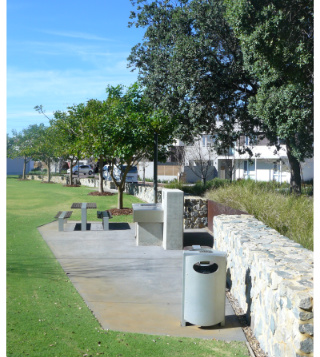|

Supporting Infrastructure can improve amenity and
encourage people to be more active and utilise spaces
Source: TPG Town Planning and Urban Design
Supporting infrastructure refers to built facilities that encourage regular and safe physical activity such as:
- Walking – footpaths, lighting, water fountains and signage
- Cycling – bike paths, bike lockers, signage and showers
- Public Transport – safe shelter and lighting
- Social interaction – seating, shade, shelter and toilets
- Recreation – seating, play equipment and facilities
Appropriate, well designed and maintained infrastructure that supports active living is critical to support recreation, social interaction and active transport options. Both the public and private sector have a role to play in providing a range of facilities and infrastructure to support better health outcomes for the community.
How to Achieve
- Shade provision is important in Australia’s climate to provide shelter from the sun, rain and wind. In public areas this should be considered in the context of the use of the facility and the needs of the potential users.
- Provide well located and designed seating with shade if needed.
- Design footpaths as part of a network with safe road crossings and ensure they are well maintained.
- Cycleways should be well marked and safe for cyclists and pedestrians if a shared facility.
- Public transport stops should be safe through visibility and lighting, be sheltered (if appropriate) and be well sign posted.
Encourage
- Lighting for night time safety, located to light up walkways, meeting places, road crossings, signage, public transport stops and other well used night time areas.
- Public toilets located in high use public areas with good signage.
- Drinking water access is important in many public areas, consideration should be given to providing a water fountain.
- Signs that are clearly written and well placed to provide essential information to the public.
|
Rule of thumb
Supporting infrastructure has the potential to enhance active living options. It is best when co-ordinated and integrated with other infrastructure and development and ideally should be part of an overall design of landscape and urban development.
|
Avoid
- Construction in an ad hoc manner with little co-ordination with other infrastructure and development.
- Infrastructure that is not maintained to appropriate standards.
Click here for more detailed information on design and planning for Supporting Infrastructure.
|
Download Full Text
Supporting Infrastructure.pdf
Resources
References
Cancer Council of NSW Sunsmart Resources
Pedestrian and Bicycle Planning: A Guide to Best Practices
Planning Guidelines for Walking and Cycling
NSW Department of Planning
Planning the Urban Forest
Urban Design Compendium - A Thriving Public Realm
Related Design Principles
Environments for All People
Social Inclusion
|
 This project was funded by the Australian Government Department of Health and Ageing.
This project was funded by the Australian Government Department of Health and Ageing.


